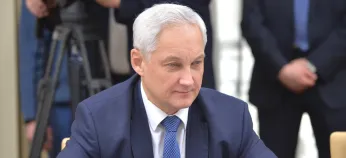
The Ukraine war means Russia needs a digital ruble more than ever
Hello! This is Alexandra Prokopenko with your weekly guide to the Russian economy — brought to you by The Bell. Our top story is Russia’s digital ruble and why it could be of significant use to the Kremlin while it wages its brutal war in Ukraine. We also look at labor market issues affecting economic growth, why Chinese banks in Russia are making major profits and annual inflation dropping below 3%.
Russia’s digital ruble and the Ukraine war
President Vladimir Putin’s invasion of Ukraine came when Russia’s Central Bank was in the midst of its own war against the legalization of crypto-currencies. The regulator was also close to launching its own digital ruble. Central Bank Digital Currencies (CBCDs) are under preparation in more than 80 countries and Russia is among the most advanced. This week, Central Bank head Elvira Nabiullina announced that Russia’s digital ruble is ready to undergo testing. Why do the Russian authorities need this and is it really money?
What is the digital ruble?
CBCDs will be a third form of money in the current system. The first and second are cash and non-cash funds. Cash funds are created by central banks, non-cash funds by the banking system (more on this here). CBDCs will combine aspects of both. The easiest way to think of a CBCD is as a crypto-currency issued by a central bank with its own unique digital code. However, unlike regular crypto-currencies, CBDCs have an issuer — the state.
The Central Bank had planned to start testing its digital rubles with 13 banks in April. However, the legal framework is not yet ready, so the tests will be delayed. Client accounts for digital rubles are expected to be opened on the Central Bank’s online platform, and both individuals and companies will be able to access them via accredited banks.
Amid Western sanctions, Russia’s isolation from international financial systems and the exclusion of leading Russian banks from SWIFT, the digital ruble could be a solution to the problem of international transactions. Initially, the Central Bank built in the possibility of interaction between the digital ruble and other CBDC platforms. Even before the war, the bank’s deputy chairwoman Olga Skorobogatova hinted that digital rubles could be a way to move beyond SWIFT.
However, the entire evolution of money is about securing public trust. Regulators have yet to deal with the tensions arising around CBDCs as a new form of money.
Too much effort?
At present, the Central Bank is pitching the digital ruble as a means for individuals to make payments. All public promotion of the idea (such as these examples: 1, 2, 3) focus on how people can access digital rubles and make payments. In this sense, the digital ruble is no different from ordinary non-cash money. And therein lies the big question: is there any public demand for a digital ruble?
One important detail: neither loans nor saving will be possible in digital rubles, the Central Bank explained to The Bell. “The digital ruble is created as an additional means for payments and money transfers, not as a means of saving or borrowing,” a Central Bank spokesperson said.
This limitation means that digital rubles are not exactly money. By definition, money is a financial asset that combines three functions: a means of exchange or payment, a store of value and a unit of account. There can be many financial assets in circulation, not all of which are stores of value (for which the asset must have a stable cost). Hardly any serve as units of account, through which the prices of goods, services and assets can be set. By deliberately removing one of these three functions (savings), the digital ruble is transformed from being “money” to being a payment system with some monetary characteristics.
Destabilization
One of the risks of CBDCs, discussed by regulators around the world, is the possible destabilization of banking systems if customers move from traditional non-cash money to the digital money of central banks. This is especially pertinent in economies more vulnerable to systemic banking crises. In these markets, it makes sense to make deposits in CBDC, because they would not be affected in the event of a bank collapse.
A reduction in deposits could weaken the banking system. This, as well as the speed of the flow of money from non-cash to digital, represents a risk. Central banks need to pay particular attention to questions of financial stability and liquidity management. With the digital ruble, the Central Bank promises to compensate banks for any possible outflows. However, most banks are lukewarm towards the digital ruble.
Convenient for the government
However, digital money is very convenient for officials. “Once this tool is in use, we will gradually start using it for budgetary purposes,” Finance Minister Anton Siluanov has said. First and foremost, this means spending in digital rubles. This will need to be targeted — digital rubles can be designated in a way that makes them impossible to spend except in agreed circumstances. The Central Bank promises there will be no inflationary consequences because there will be no changes to the sum of the money supply, merely its structure.
State Duma deputies are willing to go further and have suggested several ways to encourage the use of digital rubles. Among other initiatives, they have suggested a ban on exchanging them for currencies of unfriendly nations to targeted emissions to finance infrastructure projects. When Russia’s budget currently depends on the willingness of China and India to purchase Russian oil, a former federal official said that targeted emissions no longer seem unrealistic. “There is no money to build the necessary infrastructure towards the east, but we need it,” he explained.
Money for China
CBDCs have the potential to greatly simplify cross-border transactions (subject to the creation of a suitable infrastructure). In describing three scenarios for the development of CBDCs, the IMF singles out cross-border operations in each. Their parameters and volumes can be regulated by international agreements. These transactions do not need traditional inter-bank interactions, which means it is no longer necessary to rely on SWIFT.
Since Russia’s leading banks were disconnected from SWIFT, the Russian authorities have been seeking a solution to cross-border financial activity, and using digital rubles might be the answer. From the start the Central Bank built in the possibility of integrating digital rubles with the digital platforms of other Central Banks.
There are already negotiations over linking Russian and Chinese digital currencies and a pilot scheme could start as early as 2024, said Anatoly Aksakov, chairman of the State Duma’s financial markets committee.
Here, though, Russia runs the risk of becoming even more dependent on China. The Chinese have been testing their CBDC prototype, E-CNY, as a third form of domestic money for the past two years. Last fall, about 140 million Chinese citizens had E-CNY digital wallets, and the trade volumes were more than 62 billion yuan ($9 billion). It’s likely that Beijing, being more advanced, will set the terms and conditions for any joint platform, leaving Moscow to play second fiddle.
The other most plausible partner is Iran. Moscow and Teheran already agreed to pair the Mir and Shetab payment systems. But, even once technological questions are resolved, there remain decisions about which currency will be used to determine price (currently it’s the U.S. dollar), as well as exchange rates and currency turnover.
Why the world should care
A digital currency does not fundamentally change Russia’s monetary system. However, in a wartime economy, it offers the authorities some simple solutions: it can simplify budget processes, offer ordinary people another payment system and ease transactions with China, which is actively developing its own digital currency.
Artificial support for employment slows the economy
One of the factors constraining the structural transformation of Russia’s economy is the population’s limited mobility, Central Bank analysts argued in a recent report. The Russian labor market continues to react to shocks by reducing working hours (and thus salaries) rather than laying people off (more on the labor market here).
One important feature of the current crisis is the way it has different impacts on different industries. Thus, in aviation, trade and manufacturing, there are more part-time workers. All of these sectors have a high dependence on imported components. Meanwhile, in land transport, construction and mining, part-time work has decreased. These industries have adapted quicker than others and, in some cases, are even facing labor shortages.
At the same time, low mobility between sectors and regions means that the flow of workers from “idle” industries to those facing a labor shortfall remains very sluggish.
As a rule, workers are unwilling to move from socially stable cities or regions. Instead, they are more likely to accept reduced working hours or unpaid leave. Employers also artificially boost employment, partly due to the fear of inspections and fines from the regulators. This limited mobility leads to high competition for workers, pushing up salaries faster than productivity. Analysts warn that this increases inflationary risk and could hamper the restructuring of the economy. They stress the need to abandon this artificial support for employment, train people for new careers and develop the rental housing market.
Why the world should care
Russia is an emerging economy with the demographic structure of a developed nation, i.e. an aging population. Imbalances in the labor market are among the biggest problems facing the Russian economy. The war with Ukraine is aggravating the situation: military contracts with high salaries are already leading to an outflow of personnel and a shortage of labor. The longer the war continues, the more significant this will be in limiting economic growth.
Profits rise tenfold for Chinese banks in Russia
Subsidiaries of Chinese banks operating in Russia have been one of the main beneficiaries of Russia’s increasing isolation from the West and pivot to the East, according to Frank Media. Assets of Chinese banks have grown many times over, and profits are up 10 times, according to documents reported by Frank Media’s sources.
There are four banks with Chinese private capital working in Russia.
- Assets of ICBC (a subsidiary of the Industrial and Commercial Bank of China) increased 2.3 times to 214.7 billion rubles ($2.7 bln) in 2022. Profits went up to 13.3 billion rubles ($160 mln) in the same timeframe.
- Like ICBC, the Russian subsidiary of Bank of China has enjoyed an increased number of clients for its cash settlement services.
- In 2022, China Construction Bank’s assets increased threefold to 60.6 billion rubles ($76 million), while profits soared 33.7 times to 800 million rubles ($10 million).
- The fourth Chinese bank, a subsidiary of the Agricultural Bank of China, has yet to publish its figures.
This expansion in business for Chinese banks stems from a significant increase in the client base as more Chinese companies enter the Russian market. The trend is expected to continue in 2023 as we see more settlement operations and lending to the Russian subsidiaries of Chinese companies.
Annual inflation in Russia falls below 3%
Weekly inflation in Russia slowed to 0.04% from 0.11% between April 11 and April 17, according to the Economic Development Ministry. At the same time, the annual inflation rate dropped from 3.15% to 2.82%.
Public inflationary expectations continue to fall, while businesses expect prices to increase, the Central Bank reported. In April, public expectations for inflation in the coming year returned to a range we saw during the period of low inflation from 2017-2020. According to the study, people expect prices to increase by 10.4% over the next 12 months. Businesses expect prices to increase over the next three months.
Average daily federal spending increased to 122 billion rubles in April, according to the Electronic Budget portal. To keep to the projected spending plan for the rest of the year, the Finance Ministry can only spend 76 billion rubles per day, which is 40% less than the average expenditure in early April.
In the first quarter, Russia’s current account surplus dwindled to $19 billion (in the first quarter of 2022 it was over $70 billion) due to the contraction of Russia’s trade surplus, the Central Bank reported. Exports of goods were down, largely due to falling commodity prices. At the same time, the cost of imported goods returned to last year’s levels.
What to watch in the coming week
- Rosstat – industrial output in Q1 2023 (26 April)
- Rosstat – weekly inflation April 18-24 (26 April)
- Rosstat – overdue wages as of April 1 (26 April)
- Central Bank board meeting to establish base rate (28 April)
- Central Bank to publish an updated economic outlook and monetary policy report (28 April)
Further reading
- What Russia’s First Gas Pipeline to China Reveals About a Planned Second One, explains Sergey Vakulenko
- Russia’s New Conscription Law Brings the Digital Gulag Much, Much Closer, argues Tatiana Stanovaya
- Janis Kluge looks into the details of Russia’s war budget
The author of this newsletter is one of Russia’s leading writers on this topic: independent economic analyst Alexandra Prokopenko. Alexandra worked as an advisor at Russia’s Central Bank and Moscow’s Higher School of Economics from 2017 to 2022 — and before that she was an economic journalist for Vedomosti, then Russia’s leading business newspaper. Today, Alexandra is a columnist at the Carnegie Endowment for International Peace and a visiting fellow a the Center for Order and Governance in Eastern Europe, Russia, and Central Asia at the German Council on Foreign Relations. She holds an MA in Sociology from the University of Manchester.




